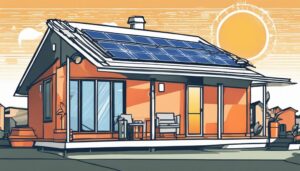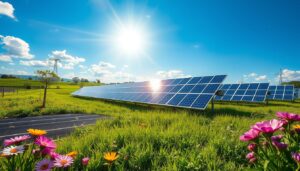
So, you’re considering investing in home solar power, but you’re not quite sure about the cost. Did you know that the average cost of a 6kW home solar system can range from $4,000 to $6,000? And a 10kW system can cost between $7,500 and $10,500.
But there’s more to it than just the initial price tag. Understanding the full scope of what goes into the cost of home solar power can help you make an informed decision about whether it’s the right choice for you.
Key Takeaways
- The cost of home solar power systems depends on the size and premium options, with a 6kW system ranging from $4,000 to $6,000 and a 10kW system costing between $7,500 and $10,500.
- Wholesale equipment costs, currency fluctuations, and the phasing out of federal solar rebates can impact the overall cost of solar systems.
- Government incentives, rebates, feed-in tariffs, renewable energy certificates, tax credits, grants, and subsidies can help reduce the initial investment in home solar power.
- Solar panels have a relatively short payback period, ranging from 2.6 to 5.2 years, and offer long-term financial savings by reducing reliance on grid electricity.
Understanding Solar PV Technology
Solar PV technology plays a crucial role in determining the cost of home solar power. The average cost of a 6kW system typically ranges from $4,000 to $6,000, while a 10kW system costs between $7,500 and $10,500. Keep in mind that premium options are available at a 20-30% increase in cost.
It’s essential to compare multiple installers in your area to find the best prices and options. By using an easy and convenient comparison tool, you can make an informed decision about solar panel installation.
Factors such as wholesale equipment costs, currency fluctuations, and the phase-out of federal solar rebates can impact the overall cost of solar systems. While future solar panel costs are expected to gradually decline, the phased-out STC rebate may cause the average cost of residential systems to increase annually.
In major Australian cities, estimated price ranges for residential solar systems can vary widely, from $2,800 to $14,100, depending on the size of the system.
Understanding the intricacies of solar PV technology is key to comprehending the cost implications of home solar power.
Initial Costs of Solar PV Systems
Understanding the technology behind solar PV systems and how it impacts the cost of home solar power is essential in assessing the initial costs of solar PV systems. Here are some key points to consider:
- Cost Range: The initial cost of a 6kW solar PV system can range from $4,000 to $6,000, while a larger 10kW system typically costs between $7,500 and $10,500. These costs can vary based on factors such as the quality of products and installation services.
- Premium Options: Premium solar system prices are available, costing 20-30% more than standard offers due to higher equipment costs. These premium options may include advanced features or higher efficiency components.
- Influencing Factors: Wholesale equipment costs, manufacturing locations, and currency fluctuations can influence solar panel prices. Additionally, the phasing out of the federal solar rebate program (STC) by 2030 is expected to lead to an increase in the net cost of solar systems.
It’s important to consider these factors when evaluating the initial costs of solar PV systems for your home.
Financial Incentives and Rebates
When considering the cost of home solar power, taking advantage of financial incentives and rebates can significantly reduce the initial investment. Government incentives and rebates, such as solar rebates, feed-in tariffs, renewable energy certificates, tax credits, and grants and subsidies, play a crucial role in making solar power more affordable. For instance, the Australian Federal Government provides a solar system rebate, offering a discount on solar power packages.
Additionally, optimizing solar self-consumption rates can maximize the return on investment, especially considering that feed-in tariff rates vary by state and are generally lower than buying power rates. Joining a Virtual Power Plant program can also lead to discounts on solar battery costs.
To help consumers make informed decisions, a payback period calculator is available to determine the payback period for a specific solar system, using conservative assumptions for a typical residential scenario.
|
Financial Incentives and Rebates
|
Benefits
|
|---|---|
|
Solar rebates
|
Discounts on solar power packages
|
|
Feed-in tariffs
|
Maximizing return on investment
|
|
Renewable energy certificates
|
Financial incentives for using renewable energy
|
|
Tax credits, grants, and subsidies
|
Additional financial support for solar power installation
|
Long-Term Savings and ROI
To maximize your long-term savings and return on investment with home solar power, it’s crucial to consider factors such as payback periods and potential future price changes. Here are some key points to consider:
- Payback Period: Solar panels offer a relatively short payback period, typically ranging from 2.6 to 5.2 years. This means that the initial investment in solar panels can be recouped in a relatively short amount of time, after which you can enjoy significant financial savings on your electricity bills.
- Energy Independence: By installing a solar system, you can significantly reduce the amount of energy purchased from electricity retailers. This reduction in reliance on grid electricity can lead to substantial long-term financial savings, particularly as electricity prices continue to rise.
- Maximizing Solar Self-Consumption: Utilizing solar power before drawing energy from the grid and selling surplus energy back to retailers through feed-in tariffs can further enhance your return on investment over the long term. Optimizing solar self-consumption rates is crucial for increasing the overall financial benefits of solar systems.
Considering these factors, despite potential future price increases, home solar power in Australia remains a worthwhile long-term investment, offering both environmental and financial benefits.
Maintenance and Operational Expenses
Considering the minimal maintenance required for solar panels and their long-term financial benefits, it’s essential to understand the associated operational expenses for ensuring optimal performance over time.
Solar panels typically require regular dusting and clearing of dirt or debris every few months to maintain efficiency. Additionally, annual inspections are recommended to check the overall efficiency and condition of the panels. However, these maintenance tasks are relatively minimal compared to the potential long-term savings from solar power.
The systems are designed to last for 20 years and are durable enough to protect the roof from the elements, reducing the need for extensive maintenance. As a result, the operational expenses for solar panels remain relatively low. The main costs involved are periodic cleaning and inspections to ensure optimal efficiency and performance.
With the minimal care required and the long lifespan of the systems, the overall maintenance and operational expenses for home solar power are manageable and contribute to the system’s cost-effectiveness over time.
Frequently Asked Questions
Are Solar Panels Worth It Australia?
In Australia, solar panels are worth it due to government incentives, declining future costs, and the potential for long-term savings. Compare quotes from multiple installers to find the best price and options for your home.
How Much Does a Solar System Cost in Australia?
In Australia, solar system costs can vary based on the city and system size, ranging from $2,800 to $14,100 for residential systems. Factors like location, system size, and energy consumption patterns influence the price.
Is 6.6 Kw Solar Enough?
If you’re considering a 6.6 kW solar system, it can be sufficient for many homes, especially with efficient energy use. Factors like your location and energy needs will help determine if it’s enough for you.
How Do I Know if My Solar Panels Are Saving Me Money?
To know if your solar panels are saving you money, track your energy bills before and after installation. Consider factors like feed-in tariffs, usage patterns, and location. Compare the savings with the initial cost to determine the overall benefit.
Conclusion
In conclusion, when considering the cost of home solar power, it’s important to take into account factors such as the initial investment, financial incentives, long-term savings, and maintenance expenses.
While the initial cost may seem high, the potential for long-term savings and return on investment, along with government incentives and rebates, make home solar power a viable and cost-effective option for many homeowners.
It’s worth exploring the potential cost savings and environmental benefits of implementing a solar power system for your home.



